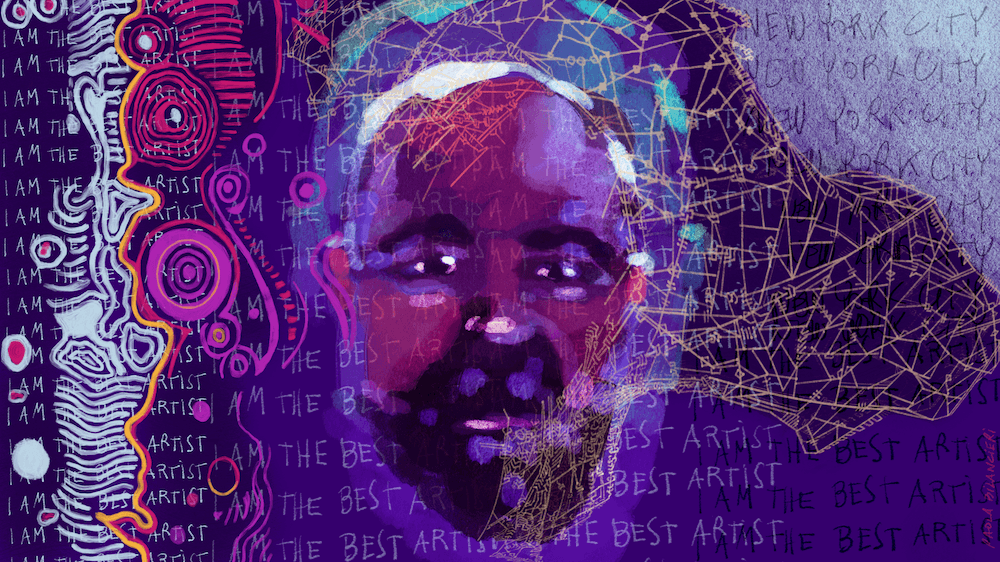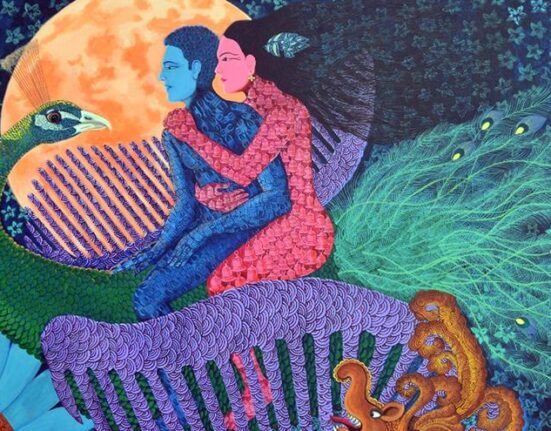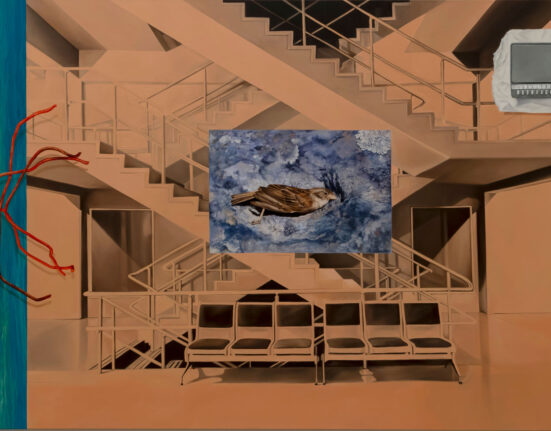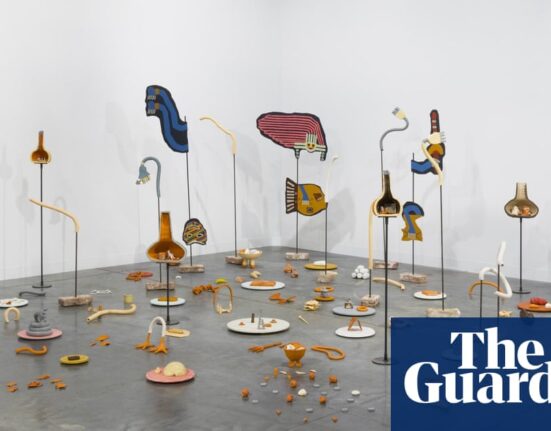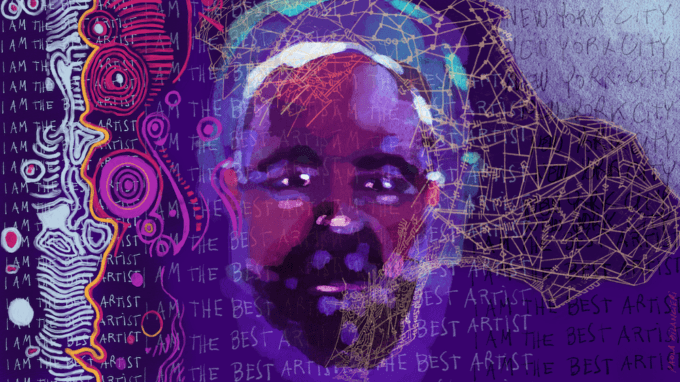
Illustration by Paola Bilancieri.
Nobody likes to provoke people more than my friend René Moncada, an artist who has been shunned by the art world. His revenge has been to display his art in alternative public spaces where his work can’t be ignored.
We met in the 1980s in Soho, New York, where we both lived. For many years Soho has been an important art and touristic neighborhood in Manhattan. We’re from South America (I’m from Argentina and he from Venezuela) and we share an unusual sense of humor (my daughter calls it weird) that has made us fast friends.
His most iconic street painting said it all: “I Am The Best Artist,” signed René. It had a background of thick multicolored vertical lines covering the street level wall on West Broadway. This infuriated the artists living in the neighborhood who would throw paint over his work to discourage him. Little did they know. Instead of feeling defeated, he returned with cans of paint, and, incorporating the graffiti, patiently recreated the mural. Police officers would catch graffiti artists defacing René’s work and asked if he wanted to press charges. “Oh, no, please don’t,” said René. “They add character to my painting.”
In 1976, René and his wife, Joanne, moved to a loft in Soho which they transformed into their home with an art gallery attached. Soon after they started living together, Joanne told him, “René, I will handle the finances, so just devote yourself to your art.” René was in heaven, since he is totally ignorant about the practicalities of daily life.
Despite René’s relentless efforts, neighborhood gallery owners refused to see his work or offer him a show. Robert Hughes, who was the chief art critic for Time Magazine, said: “René, I can assure you that you are not the best artist.” Undeterred, René once asked Leo Castelli, the legendary art dealer with a gallery in Soho, “Mr. Castelli, I know that you are very busy, but why don’t you come to my gallery during your lunch hour?” Castelli responded, “I don’t eat lunch.”
Constantly rejected by local gallery owners, René asked the owner of Skrambles, then a popular restaurant in the heart of Soho, if he could paint the exterior side wall of the restaurant. The owner agreed and using three sheets of plywood covered with canvas, René started painting; afterwards, no one from the art world who passed by could say they had never seen his art.
René continued to paint murals throughout Soho and his paintings became somewhat of a legend. Photographs of his murals were used in tourist guides, backdrops for international fashion magazine photo shoots, appeared in the opening credits of the TV sitcom, “We Got it Made,” and in the movie, “The Secret of my Success,” starring Michael J. Fox.
*
René had long been concerned with the environment. In 1980 he read in The New York Times that garbage had invaded the beautiful Venezuelan beaches. In September of that year, he traveled to Caracas and contacted the National Art Gallery (Galería de Arte Nacional). René asked the director of the gallery if he would be interested in a piece that would expose how garbage was ruining the country’s natural resources. Reluctantly, the director said there was going to be an opening in a month due to a cancellation, thinking that, on such short notice, René wouldn’t have time to prepare for the show and would reject his offer. René immediately accepted and the director asked what he planned to show. René said he would create a sculpture with garbage collected from the public beaches.
The day of the show René came to the gallery with a pick-up truck filled with empty beer cans, toilet seats, broken dolls, old shoes and everything else he had collected from the beaches. Questioned by the guards, René showed them the director’s authorization letter and they allowed him to enter the museum with eight huge garbage bags full of refuse with which he would create his sculpture. When the director arrived, René revealed his plan. He had dispersed the garbage in the main hallway at the entrance because he was not given space for his sculpture. He promised to clean it up and instead of having an opening he said would have a closing. This gave him time to create the sculpture, contact the press and invite the public.
Soon, several newspapers and television reporters went to see René’s exhibit. One reporter asked what the title of the piece was. René replied, “Garbage.” “No,” the reporter said, “it would be garbage if it was still at the beach, but once you brought it into the museum, you instilled a message.” On the spot René decided to call his sculpture, “Monument to Venezuelan Apathy.” At the end of the show, the Galería de Arte Nacional bought the sculpture.
After this incident, René carried out additional exhibitions highlighting the environmental problems in Venezuela. In 1984, using the sculpture made for the National Art Gallery, he suspended the garbage from the ceiling at the entrance of a group show at The Venezuelan Telephone Company (CANTV). IN 1986, to publicize the pollution in Lake Maracaibo, he took a 10×20 feet canvas and using a beach ball to keep it afloat, dragged it over the waters of Lake Maracaibo, a lake killed by oil companies. He was determined to show the damage pollution was causing. Lake Maracaibo is considered as the largest lake in South America and today an environmental catastrophe. Called “Naturaleza Muerta” – Still Life in English or literally “Dead Nature,” an oil painting created with black waters (in architectural terms, sewer waters) of Lake Maracaibo, René laid the canvas in front of the National Gallery. And in 1988 René again constructed a pile of garbage cleaned from Venezuelan beach in front of the National Gallery. During his performance, René was visited by members of the Venezuelan secret police who told him that his actions were an embarrassment to the country. Friends from the media explained to René that they were not giving him advice but that he could be punished for his actions. René understood the message and left Venezuela.
*
Over the years René illustrated several covers for Screw magazine, whose publisher Al Goldstein, was a friend and accomplice. In 1983, René convinced Goldstein to dress as Jesus Christ and carry a 5-foot-tall recreation of a cross with a vulva sculpted in the center which he called “Sex and Violence.” The idea was that Goldstein would climb the steps of St. Patrick’s Cathedral on Fifth Avenue in New York and be turned away. René claimed that if Jesus Christ were to return today, he wouldn’t be accepted in the cathedral, and rejecting his sculpture would show that in the U.S. there is no freedom of expression or separation of Church and State, therefore no respect for the human rights of the individual.
He dressed Goldstein as Jesus with a crown of thorns made of wire, a long blond wig and a white robe with a rope for a belt. The event was filmed for Goldstein’s TV cable show Midnight Blue. Goldstein climbed the steps of the cathedral and, with a colleague, approached the Cathedral. “Jesus” was turned away before entering. Everything happened as predicted: the event was filmed, and Al Goldstein got into his limousine and drove away. René and his friends were packing up and ready to leave when police arrived and detained them.
After being caught up in traffic, Al returned. More officers arrived and the police ordered the crew to stop filming on the ground that they didn’t have a permit. But Goldstein told the crew, “Keep on filming. This is America, not Iran.” The police arrested René, Goldstein and members of the crew, and kept them in jail while trying to determine what charges warranted their arrest. They were finally charged with disturbing the peace.
A few weeks later René testified in court. He explained to the judge that if a black man was arrested for disrespecting a white man and behind the judge was the symbol of the KKK, that would give him a clear idea of what would happen to him. If a Jew accused of being disrespectful to the Third Reich and behind the Judge there was a swastika, that too would give him an idea of what would happen to him. They were being accused of being disrespectful to the Christian God and behind the judge it says, “In God we Trust.” René told the judge that it should say “In the Constitution of the United States We Trust” or “In the Judicial System of the United States We Trust.” The symbol they carried represented his philosophy and belief. The vulva is nothing more that the female organ of reproduction created by God to give life to Jesus, whereas the cross was created by man to torture and kill Jesus. “I consider the vulva as the purest image, a sublime image, nature’s paragon, said René. The judge, a woman, (who had been listening to him in disbelief) dismissed the case. Covering the microphone with her hand she told René, “Don’t do this again because next time you might not be so lucky.”
*
René again demonstrated his unlimited capacity for mischief with a show at the Museum of Modern Art (MOMA) in New York. In 1988, I received an invitation from René that read:
Vent Elation
Join René, his friends and his patrons
As they take an important step toward
The liberation of art
The event will take place at the
Museum of Modern Art, 3rd floor
On Thursday, May 5, 1988
From 5 p.m. to 9 p.m.
Museum Admission: Pay what you wish
I couldn’t believe René had made it to the MOMA. On the day of the show there was a crowd at the entrance of the museum. I rushed to the ground floor and couldn’t find René’s show, then to the second floor, also nothing by René. But when I reached the third floor, I saw René standing next to an air vent. He was being interviewed by a TV reporter. “René,” I said, “where the hell is your show?” He laughed and, proudly pointing to the vent next to him he said, “This is my show.” “What do you mean, this is my show?” “Well, Marcel Duchamp said that ‘Any manufactured object can be promoted to the dignity of an object of art through the choice of the artist,’ so I am just following his example.” Calling his piece the E-Vent, it encompasses five major theories in modern art: the ready-mades of Marcel Duchamp, Dada, site-specific, minimalism, and conceptual art.
*
Another audacious move was René’s illustration of the can of Mott’s Apple Juice. René saw that the center of the apple on the can of Mott’s Apple Juice resembled a vulva. Being a talented artist, René executed a photo-realistic painting of the Mott’s Apple Juice can. Throwing himself an opening in his gallery, he invited the local media and contacts at magazines. The painting was published in the Village Voice, Screw, Oui, Swank, High Society, and Playboy magazines (both the U.S. and German editions) and he was interviewed at his gallery by Playboy’s TV cable show. The publicity that followed forced the Mott’s Apple Juice company to change their iconic logo at the cost of thousands of dollars; it also put René on the map. As he told me, “The Mott’s Apple Juice painting was a consequential moment in my career as an artist because it allowed me to demonstrate the hypocrisy of the art establishment. Art doesn’t need to be good. All that is necessary is for a gallery or an art critic to say that the art is important. Art has become a commodity and a money-laundering business.”
*
Among many other projects, René has created sculptures made of Styrofoam which he considers the worst offender to the environment because it is non-biodegradable, cannot be recycled and is toxic. Covered with brown packing tape and paper pulp, he has been teaching children-at-risk and in jails how to make them. René’s main concern has been to replace self-censorship with self-esteem, explaining that you can teach art but you cannot teach imagination. These sculptures trigger their imagination. “I believe that art education is more important than any other type of education. Without art, or drawing to be specific, there would be no academic studies. Letters are the drawings of sounds just like musical notes. Art is the individual’s basic means of communication. Before there was a written language, there was art,” he says.
Through his art and his work, René has shown that he is not only an artist but also a showman. And although he hasn’t gained the recognition of New York’s top art galleries, he has already left an indelible mark on the New York art scene.

